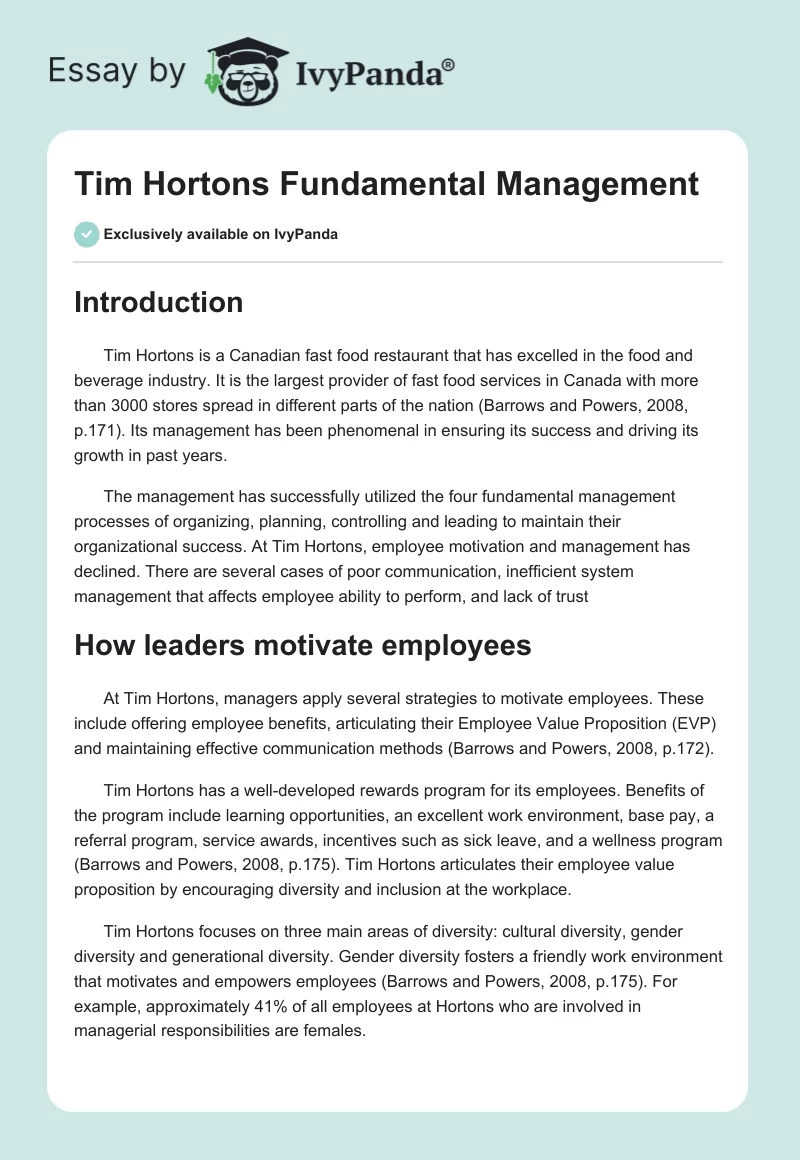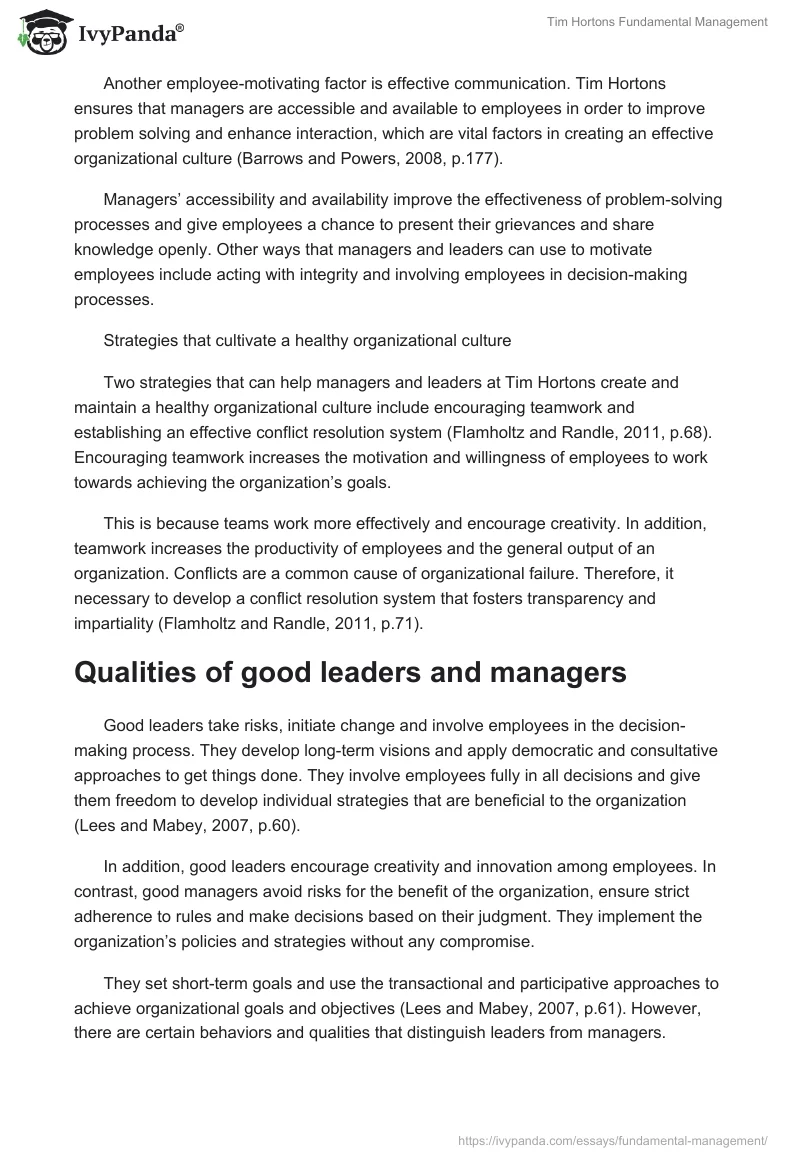Introduction
Tim Hortons is a Canadian fast food restaurant that has excelled in the food and beverage industry. It is the largest provider of fast food services in Canada with more than 3000 stores spread in different parts of the nation (Barrows and Powers, 2008, p.171). Its management has been phenomenal in ensuring its success and driving its growth in past years.
The management has successfully utilized the four fundamental management processes of organizing, planning, controlling and leading to maintain their organizational success. At Tim Hortons, employee motivation and management has declined. There are several cases of poor communication, inefficient system management that affects employee ability to perform, and lack of trust
How leaders motivate employees
At Tim Hortons, managers apply several strategies to motivate employees. These include offering employee benefits, articulating their Employee Value Proposition (EVP) and maintaining effective communication methods (Barrows and Powers, 2008, p.172).
Tim Hortons has a well-developed rewards program for its employees. Benefits of the program include learning opportunities, an excellent work environment, base pay, a referral program, service awards, incentives such as sick leave, and a wellness program (Barrows and Powers, 2008, p.175). Tim Hortons articulates their employee value proposition by encouraging diversity and inclusion at the workplace.
Tim Hortons focuses on three main areas of diversity: cultural diversity, gender diversity and generational diversity. Gender diversity fosters a friendly work environment that motivates and empowers employees (Barrows and Powers, 2008, p.175). For example, approximately 41% of all employees at Hortons who are involved in managerial responsibilities are females.
Another employee-motivating factor is effective communication. Tim Hortons ensures that managers are accessible and available to employees in order to improve problem solving and enhance interaction, which are vital factors in creating an effective organizational culture (Barrows and Powers, 2008, p.177).
Managers’ accessibility and availability improve the effectiveness of problem-solving processes and give employees a chance to present their grievances and share knowledge openly. Other ways that managers and leaders can use to motivate employees include acting with integrity and involving employees in decision-making processes.
Strategies that cultivate a healthy organizational culture
Two strategies that can help managers and leaders at Tim Hortons create and maintain a healthy organizational culture include encouraging teamwork and establishing an effective conflict resolution system (Flamholtz and Randle, 2011, p.68). Encouraging teamwork increases the motivation and willingness of employees to work towards achieving the organization’s goals.
This is because teams work more effectively and encourage creativity. In addition, teamwork increases the productivity of employees and the general output of an organization. Conflicts are a common cause of organizational failure. Therefore, it necessary to develop a conflict resolution system that fosters transparency and impartiality (Flamholtz and Randle, 2011, p.71).
Qualities of good leaders and managers
Good leaders take risks, initiate change and involve employees in the decision-making process. They develop long-term visions and apply democratic and consultative approaches to get things done. They involve employees fully in all decisions and give them freedom to develop individual strategies that are beneficial to the organization (Lees and Mabey, 2007, p.60).
In addition, good leaders encourage creativity and innovation among employees. In contrast, good managers avoid risks for the benefit of the organization, ensure strict adherence to rules and make decisions based on their judgment. They implement the organization’s policies and strategies without any compromise.
They set short-term goals and use the transactional and participative approaches to achieve organizational goals and objectives (Lees and Mabey, 2007, p.61). However, there are certain behaviors and qualities that distinguish leaders from managers. Leaders are open-minded, flexible and persuasive. In contrast, managers are narrow-minded, rigid, commanding and authoritative (Lees and Mabey, 2007, p.63).
Leaders are open to change, new ideas and opinions while managers strive to maintain the status quo, are resistant to change and do not accept new ideas and opinions. Leaders involve employees in decision-making processes and always persuade them by explaining the benefits of applying certain strategies. In contrast, managers give orders and do not feel obligated to explain their decisions to employees.
Recommendations
Tim Horton’s management can improve their organizational culture by introducing strategies that are more effective than the current ones in motivating employees. For example, they can develop work schedules that enable workers to spend more time with their families. In addition, encouraging teamwork and increasing the frequency of service awards could increase employee motivation significantly. Currently, service awards are rare and are given to employees who have worked at Tim Hortons for a considerable length of time.
Conclusion
Management is an important aspect in the achievement of organizational goals and objectives because managers influence all aspects of an organization’s operations. Managers have the sole responsibility of guiding their organization in achieving goals and objectives. Managers and leaders should always motivate their employees because employee motivation is one of the strategies that successful managers use to achieve the goals and objectives of their organization.
Motivating employees improves their self worth, encourages teamwork, and improves their productivity and output. Encouraging teamwork and establishing an effective conflict resolution system are strategies that can help managers and leaders create and maintain a healthy organizational culture. Despite their different qualities and behaviors, managers and leaders make significant contributions in the achievement of organizational goals.
References
Barrows, C., and Powers, T. (2008). Introduction to Management in the Hospitality Industry. New York: John Wiley and Sons.
Flamholtz, E., and Randle, Y. (2011). Corporate Culture: The Ultimate Strategic Asset. New York: Stanford University Press.
Lees, T., and Mabey, C. (2007). Management and Leadership Development. New York: SAGE Publishers.


